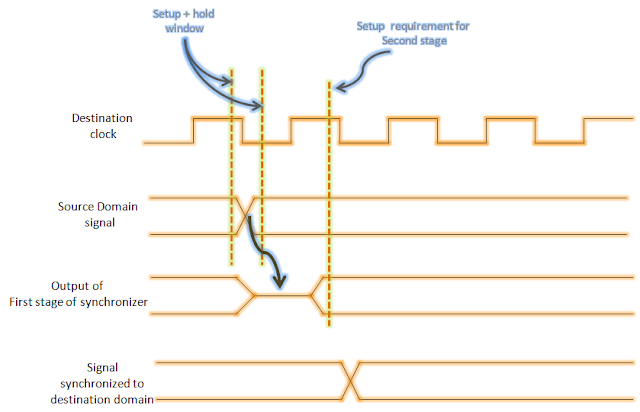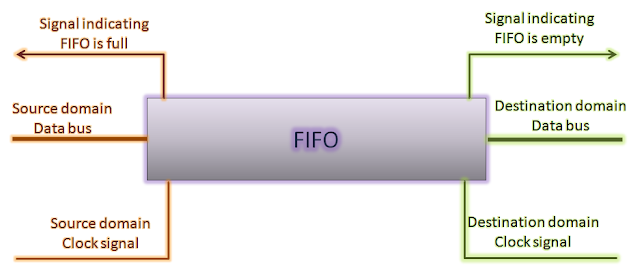In this realistic world, nothing is ideal. A signal travelling
along a wire/cable/transmission line is susceptible to noise from the
surroundings. Also, there is degradation in signal due to parasitic elements
involved in the line. Moreover, the output signal produced by the transmitter
itself only does resemble the ideal signal thereby worsening the scenario. There
are repeaters/buffers along the line to minimize the impact of noise. But there
is a limit up to which degradation is allowed beyond which the receiver is
unable to sense the correct value of the signal. This degradation is measured
in terms of noise margins. One can find the topic discussed in all the
textbooks related to digital logic and system design might it be CMOS, TTL or any
other logic family.
Let us illustrate the concept of noise margins with the help of an
example. Let us assume that a signal has to travel from a transmitter to a
receiver through an inter-connect element (or, commonly called as a net) which will only degrade the signal, since there is no active element in-between transmitter and receiver. The
output signal produced by Transmitter (Tx) will deviate from ideal voltage
levels as is shown in figures 1 and 2 for logic level ‘1’. In addition, there
will be signal degradation by inter-connect element as well as noise induced
from the surroundings. As a result, the band of voltages that can be present at
the receiver input for logic ‘1’ will further widen. Now, there are two cases:
- If the band voltages recognized as logic ‘1’ by the receiver is super-set of the band of voltages that can exist at the receiver input as shown in figure 1, receiver will recognize the transmitted logic ‘1’ for all the cases. This is the desired scenario as no logic ‘1’ transmitted will be missed by the receiver. This scenario is depicted in figure 1, wherein the noise induced by surroundings is such that the range of voltages present at the receiver does not violate the band of voltages recognized as voltage '1' by the receiver. So, it will be recognized correctly as logic '1' by the receiver.
 |
| Figure 1: Figure showing the noise induced is less than noise margin |
2) If the band
of values recognized as logic ‘1’ by the receiver is a sub-set of the band of
voltages that can exist at the receiver input as shown in figure 2, there will
be some cases that will not be recognized as logic ‘1’, but are intended to be
recognized. So, there will be a loss of information/incorrect transmission of
information possible in such cases. This scenario is depicted in figure 2, wherein the noise induced by surroundings makes the band of voltage at the receiver's input larger than that can be decoded correctly as logic '1' by the receiver. So, there is no guarantee that the signal will be perceived as logic '1' by the receiver.
 | |
|
Let
us now label each of these regions to make the discussion more meaningful. The
lowest voltage that will be produced as logic ‘1’ by the transmitter is termed
as VOH and, let us say, highest is VDD. (We are here considered about lower
level only). So, the range of voltages produced by the transmitter is (VDD –
VOH). And let the receiver accept
voltages higher than VIH. So the range of voltages accepted by the receiver
will be (VDD – VIH). So, the maximum degradation that can happen over the
communication channel is (VOH – VIH) which is nothing but the noise margin. If
the degradation is less than this figure, the logic ‘1’ will be recognized
correctly by the receiver; otherwise it won’t. So, the noise margin equation can be given as below for logic '1':
Noise margin for logic '1' (NM) = VOH – VIH
Where
VOH = Lowest level of voltage that can be produced as logic '1' by the transmitter
VIH = Lowest level of voltage that can be recognized as logic '1' by the receiver
Similarly, for logic ‘0’, the range of outputs that can be
produced by the transmitter is (0 - VOL) and the range of input voltages that
can be detected by the receiver is (0 – VIL), thereby providing the noise
margin as:
Noise margin (NM) = VIL – VOL
Where
VIL = Highest level of voltage that can be recognized as logic ‘0’ by the receiver.
VIH = Highest level of voltage that is produced as logic ‘0’ by the transmitter.
Figure 3 shows all these levels for the example we had taken earlier to demonstrate the concept of noise margins.
 | |
|
From out preceding discussion, if the degradation over the communication channel is more than noise margin, it will not be detected correctly by the receiver. So, it is imperative for the designer to design accordingly.
Definition of noise margin: Thus, we can conclude this post by defining noise margin as below:
"Noise margin is the difference between the worst signal voltage produced by the transmitter and the worst signal that can be detected by receiver."
Also read:











